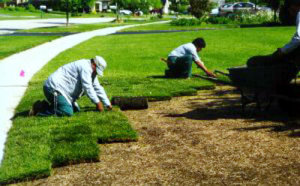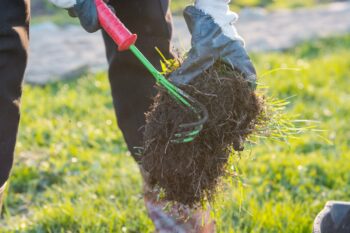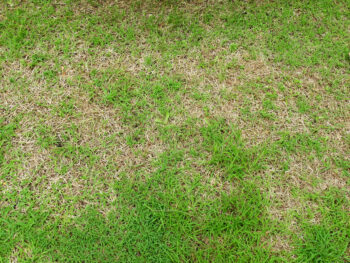Laying sod is the fastest way to produce an attractive lawn. Check out this quick video for some useful DIY tips.
 Laying sod, whether for a new lawn or for a lawn you are renovating, requires careful attention and proper handling during installation. Sod comes in rolls, or in large square or rectangular sections, that must be cut to size to cover all areas of the lawn.
Laying sod, whether for a new lawn or for a lawn you are renovating, requires careful attention and proper handling during installation. Sod comes in rolls, or in large square or rectangular sections, that must be cut to size to cover all areas of the lawn.
Take measurements of the area to be sodded with a tape measure. Sod is more expensive than seeding your lawn, and you should only buy what you need to cover the desired area of your property. Ensure that you are purchasing the right type of sod grass for your needs.
Learn more about choosing seed versus sod for North Texas lawns, so you can make the right decision for your landscape.
Sod should be installed immediately after it arrives, so be sure that the preparatory work is done ahead of the delivery. This means you want to begin preparing your lawn about 2 weeks in advance.
Here are the preliminary steps:
- Use a rototiller or spade to till the desired area at a depth of 6 inches.
- Remove all debris from the tilled area, including rocks, wood, and roots.
- Then, level the area with a rake. The soil should be 1 inch below driveways, sidewalks, and sprinklers.
- Use a lawn roller to press the soil to a level surface.
- Fill in any low areas and roll the area once again.
- Apply an herbicide to eliminate weeds, 10 to 14 days before you intend to install the sod.
- Pre-fertilize the soil with 1 pound of 6-20-20 fertilizer for each 100 square feet of prepared area.
- Finally, you should irrigate the soil prior laying the sod.
Once the initial work is completed, you can begin laying your fresh sod:
- Begin laying the sod along a straight line, such as a sidewalk or driveway.
- Butt the edges of the pieces together tightly, neither overlapping them nor leaving any spaces between them.
- Stagger the joints between rows of sod, as you would do if you were laying brick.
- Use a sharp knife to fit in corners, around trees and other obstacles.
- Once the sod is installed, water the entire lawn area to a depth of 8 to 10 inches.
- After that, you will need to water the new sod three times each day, for 15 minutes, for 10 consecutive days. This allows the root system to establish. Read more about new sod watering tips.
If you need a sod installation expert to help you in the DFW area, please call us today for a free estimate
 The sod must be kept moist at all times, whether it is waiting to be installed, laid down, or already completed. Sod can dry out quickly and die, so don’t waste money by allowing sod to perish before the root system is established in the topsoil.
The sod must be kept moist at all times, whether it is waiting to be installed, laid down, or already completed. Sod can dry out quickly and die, so don’t waste money by allowing sod to perish before the root system is established in the topsoil.
Do not allow water to pool on the new sod. If this occurs, reduce watering and give it time to soak into the turf.
Avoid watering at night.
After 10 days of keeping the sod moist to encourage root development, it is then safe to mow your lawn. Set your mower height to ensure that you do not take off more than a third of the grass blade. Don’t use a lawn rake after mowing, as it will pull up the loosely held sod.
Aside from mowing and watering, you will need to stay off the newly sodded area for three weeks in order to allow good establishment. This includes keeping children and pets off the lawn, especially large dogs. Avoiding foot traffic for a few weeks will ensure that the turf remains even and level as it roots.





8 Responses
I am going to share this post with my sister. She will definitely need to read through this. She and her husband are having a new home built and she is up in the air between seeding & laying sod.
I know you say that it’s more cost effective to seed, but how large of an area do you think it would be most beneficial to sod? Her property is less than 1 acre in total.
Good advice. Spring is just around the corner, and this on my long list of outdoor chores to get my yard ready for Spring. Thanks for the helpful tips.
Our school needed a new playground for the football team to practice. The bare ground was causing a lot of scraped knees. I’ll definitely recommend this process so the job gets done as soon as possible and we have a lush green ground soon.
This article was really interesting, and I’m glad you said that you should water the lawn to a depth of at least 8 inches. However, I’m so nervous that if I lay the sod myself, I’ll ruin the yard of my new home, especially since I think I’m going to sell in 5 years. I think I’d prefer to hire a professional lawn installation service instead of trying to do it myself.
Thanks for that fertilizer tip. I had heard before that you should use fertilizer, but I never knew how much. Thanks for describing how much to use per square foot. This should help our sod really grow. http://www.midwestturf.com/sodding
I like that you mention how it’s important to complete preparatory work before you receive your sod delivery so that you can immediately install it. In order to do this, you’d probably want to figure out how long it will take to complete the preparatory work and then start researching the different sod delivery services. This could help you find a service that fits with your schedule so that you can have everything ready.
http://novasackturffarm.com/sod-farm
My sister and her husband are planning on moving into a new construction house this July. They want to get some sod laid done by the end of August. So, it is nice to know that they will need to get accurate measurements of their yard. That does seem like something they might want to consider having a professional help them do as well.
It’s good to know that you should give fresh sod up to 10 inches of water. I just finished building my home last month, so I’m hoping that we can add sod to it sometime this week. It’d be nice to get that done before summer so my kids can play around in our backyard.